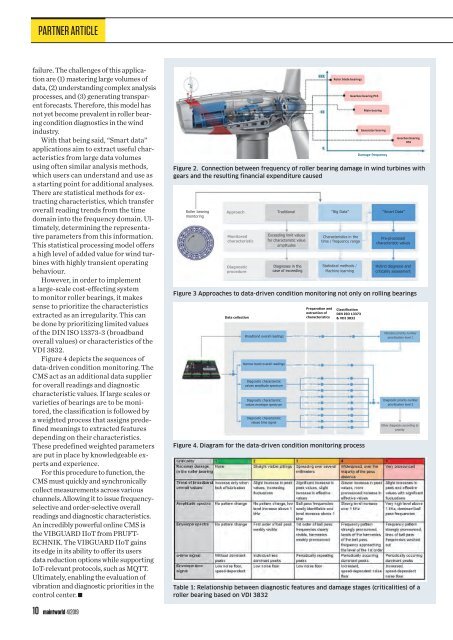Maintworld 4/2019
Machine Learning – Not a Gold-Plated Silver-Bullet Solution to Operational Woes // A Data-Driven Approach to Online Monitoring of Roller Bearings // Using Ultrasound to Enhance Energy Efficiency
Machine Learning – Not a Gold-Plated Silver-Bullet Solution to Operational Woes // A Data-Driven Approach to Online Monitoring of Roller Bearings // Using Ultrasound to Enhance Energy Efficiency
Create successful ePaper yourself
Turn your PDF publications into a flip-book with our unique Google optimized e-Paper software.
PARTNER ARTICLE<br />
failure. The challenges of this application<br />
are (1) mastering large volumes of<br />
data, (2) understanding complex analysis<br />
processes, and (3) generating transparent<br />
forecasts. Therefore, this model has<br />
not yet become prevalent in roller bearing<br />
condition diagnostics in the wind<br />
industry.<br />
With that being said, “Smart data”<br />
applications aim to extract useful characteristics<br />
from large data volumes<br />
using often similar analysis methods,<br />
which users can understand and use as<br />
a starting point for additional analyses.<br />
There are statistical methods for extracting<br />
characteristics, which transfer<br />
overall reading trends from the time<br />
domain into the frequency domain. Ultimately,<br />
determining the representative<br />
parameters from this information.<br />
This statistical processing model offers<br />
a high level of added value for wind turbines<br />
with highly transient operating<br />
behaviour.<br />
However, in order to implement<br />
a large-scale cost-effecting system<br />
to monitor roller bearings, it makes<br />
sense to prioritize the characteristics<br />
extracted as an irregularity. This can<br />
be done by prioritizing limited values<br />
of the DIN ISO 13373-3 (broadband<br />
overall values) or characteristics of the<br />
VDI 3832.<br />
Figure 4 depicts the sequences of<br />
data-driven condition monitoring. The<br />
CMS act as an additional data supplier<br />
for overall readings and diagnostic<br />
characteristic values. If large scales or<br />
varieties of bearings are to be monitored,<br />
the classification is followed by<br />
a weighted process that assigns predefined<br />
meanings to extracted features<br />
depending on their characteristics.<br />
These predefined weighted parameters<br />
are put in place by knowledgeable experts<br />
and experience.<br />
For this procedure to function, the<br />
CMS must quickly and synchronically<br />
collect measurements across various<br />
channels. Allowing it to issue frequencyselective<br />
and order-selective overall<br />
readings and diagnostic characteristics.<br />
An incredibly powerful online CMS is<br />
the VIBGUARD IIoT from PRUFT-<br />
ECHNIK. The VIBGUARD IIoT gains<br />
its edge in its ability to offer its users<br />
data reduction options while supporting<br />
IoT-relevant protocols, such as MQTT.<br />
Ultimately, enabling the evaluation of<br />
vibration and diagnostic priorities in the<br />
control center.<br />
Roller bearing<br />
monitoring<br />
Approach<br />
Monitored<br />
characteristic<br />
Diagnostic<br />
procedure<br />
Figure 3 Approaches to data-driven condition monitoring not only on rolling bearings<br />
Data collection<br />
Broadband overall readings<br />
Narrow band overall readings<br />
Diagnostic characteristic<br />
values amplitude spectrum<br />
Diagnostic characteristic<br />
values envelope spectrum<br />
Diagnostic characteristic<br />
values time signal<br />
Traditional<br />
Exceeding limit values<br />
for characteristic value<br />
amplitudes<br />
Diagnoses in the<br />
case of exceeding<br />
Preparation and<br />
extraction of<br />
characteristics<br />
Rotor blade bearings<br />
“Big Data”<br />
Characteristics in the<br />
time / frequency range<br />
Statistical methods /<br />
Machine learning<br />
Classification<br />
DIN ISO 13373<br />
& VDI 3832<br />
Gearbox bearing PCS<br />
Figure 4. Diagram for the data-driven condition monitoring process<br />
Main bearing<br />
Generator bearing<br />
Damage frequency<br />
“Smart Data”<br />
Gearbox bearing<br />
HSS<br />
Figure 2. Connection between frequency of roller bearing damage in wind turbines with<br />
gears and the resulting financial expenditure caused<br />
Pre-processed<br />
characteristic values<br />
Hybrid diagnosis and<br />
criticality assessment<br />
Vibration priority number<br />
prioritization level 1<br />
Diagnostic priority number<br />
prioritization level 2<br />
Other diagnosis according to<br />
priority<br />
Table 1: Relationship between diagnostic features and damage stages (criticalities) of a<br />
roller bearing based on VDI 3832<br />
10 maintworld 4/<strong>2019</strong>

















